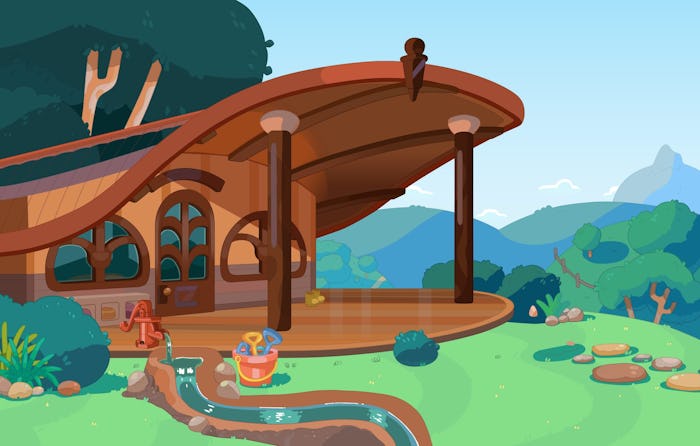Can We Enroll, Too?

Everything We Know About The Type Of School Bluey Goes To
It looks pretty darn dreamy.
For those of us who have watched Bluey, we’ve been captivated by the charm of the Heeler family and their lovely community in Brisbane, Australia. Their house is adorable and their neighborhood looks so sweet. But there’s one show location that instills in us a real sense of envy (yes, you can be envious of a cartoon dog): Bluey’s school.
The beautifully situated, whimsical campus includes a charming wooden building that almost looks as though it were built by Hobbits set amid rolling hills and big open spaces for kids to play. The Dream, truly. But what kind of school does Bluey go to? And is Bluey’s school real? After all, some locations depicted in the show are based on actual locations in Brisbane. Here’s what you need to know...
Bluey’s school is called Glasshouse Primary School.
GPS is run by an Australian Shepherd named Calypso, voiced by singer-songwriter Meg Washington (also Australian; not a shepherd). Calypso’s warm, calm aura seem to permeate everything at the school. She always tries to guide her students to solutions rather than dictate them — there’s as much to learn from the process as the solution itself. She’s often found singing, humming, and knitting, and is an excellent storyteller, much to the kids’ delight.
You can see where Bluey’s school is located in relation to the other places the Heelers are known to go. (BTW: Bluey and Bingo’s school being in literally opposite directions? Surely you could have planned that better...)
What kind of school does Bluey go to?
All the clues point to the fact that Bluey goes to a Steiner school, also called a Waldorf school. Waldorf education, which often varies school by school since they’re all autonomous, was developed by late-19th/early-20th century Austrian eccentric Rudolph Steiner. Steiner’s (it must be said: controversial) “anthroposophy” philosophy underpins a lot of the practice of these schools, and the goal of a Waldorf education is to allow children freedom of expression to develop as a whole human being, physically, mentally, and (non-denominational) spiritually. But the deeper philosophical theory itself is very much in the background of things by design and is not explicitly taught. In other words, we’re never going to have an episode where Calypso gathers the children around to talk about their spiritual development. We’re just going to see Calypso take steps to allow the children to grow and learn in a less structured way than a more “traditional” classroom.
Waldorf education for younger students like Bluey involves a daily routine of lots of free play, art, circle time, and “practical” arts like knitting, gardening, and cleaning up. (A lot of subjects we don’t find in most classrooms are often central to Waldorf education, such as art, music, gardening, and foreign language.) Another unique quirk of Steiner schools is the building itself: Steiner was an architect, and had a lot of ideas about what kind of school was going to be best for learning. Walforf schools often feature lots of rounded surfaces and edges, walls meeting at non-perpendicular angles, and light, subtle colors.
Is Bluey’s school real?
Strictly speaking? No. But was it inspired by a real school? Maybe! Kinda! Eagle-eyed fans have noticed striking visual similarities between Samford Valley Steiner School (SVSS), located about 45 minutes north of Brisbane (where Bluey lives) and Glasshouse Primary.
“We are continually striving to provide and develop a curriculum and learning programme that is inspired by a deep understanding of human development; embraces and reflects the universal values of freedom, equality, peace and democracy; and values diversity and individual worth,” the school writes on its website. “All curriculum content and experiences offered to young people during their schooling are purposefully and consciously considered in light of how and when the activity or knowledge will best support the child’s natural development. Our teachers work to create a school where goodness, beauty and truth permeate the pedagogical, physical and social fabrics.”
Honestly? This tracks with what we’ve seen of Bluey’s school. I don’t know about you, but I heard that vision statement Calypso’s voice...
Creator Joe Brumm was inspired by his daughter’s education when creating Bluey.
Brumm was still developing Bluey when his eldest daughter (he has two) began school. “Play time was suddenly taken away from her, it was just yanked and seeing the difference in her was horrendous,” he told The Father Hood. “There was no playing, there was no drawing, it was just straight into all this academic stuff. And the light in her eyes just died.”
Brumm went on to explain that he started researching the value of play in a child’s development and, as a result, switched schools to one that placed more emphasis on creative play.
“Bluey is just one long extrapolation of that,” Brumm says. “It’s to encourage people to look at play not just as kids mucking around, but as a really critical stage in their development that, I think, we overlook at their peril.”